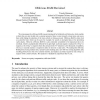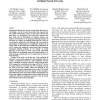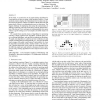CRYPTO
2010
Springer
14 years 9 months ago
2010
Springer
We reinvestigate the oblivious RAM concept introduced by Goldreich and Ostrovsky, which enables a client, that can store locally only a constant amount of data, to store remotely ...
ICMAS
2000
14 years 9 months ago
2000
The data allocation problem in incomplete information environments consisting of self-motivated servers responding to users' queries is considered. Periodically, the servers ...
ECIS
2000
14 years 9 months ago
2000
Information filtering (IF) systems usually filter data items by correlating a vector of terms (keywords) that represent the user profile with similar vectors of terms that represe...
ISTA
2004
14 years 9 months ago
2004
: Recent advances in mobile computing have enabled the deployment of broadcast based information systems such as, wireless internet, traffic information systems, etc. These systems...
APVIS
2001
14 years 9 months ago
2001
Traditional graph drawing is only concerned with viewing of data and relations amount data items. It uses a graph model to present the data items and the relations and tries to ca...
BNCOD
2004
14 years 9 months ago
2004
Abstract. Traditional recovery mechanisms are not adequate in protecting databases from malicious attacks. A malicious transaction by virtue of writing on to the database can corru...
ACSW
2004
14 years 9 months ago
2004
A data stream is a continuous and high-speed flow of data items. High speed refers to the phenomenon that the data rate is high relative to the computational power. The increasing...
ITSL
2008
14 years 9 months ago
2008
Clustering can be defined as a data assignment problem where the goal is to partition the data into nonhierarchical groups of items. In our previous work, we suggested an informati...
APVIS
2007
14 years 9 months ago
2007
In this study, we examine the use of graph ordering algorithms for visual analysis of data sets using visual similarity matrices. Visual similarity matrices display the relationsh...
ACSW
2007
14 years 9 months ago
2007
Traditional DHT (Distributed Hash Tables) abstraction distributes data items among peer nodes on a structured overlay network. This introduces a number of issues when nodes are un...



